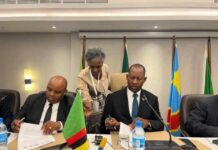Zambia’s second Eurobond will prove costlier than its debut issue in 2012 after the budget deficit ballooned in the nation, which lost its spot as Africa’s biggest copper producer last year.
Spending reforms by President Michael Sata, whose 2011 election victory ended two decades of rule by a single party, were met by a Fitch Ratings downgrade last year deeper into junk and the continent’s worst bond performance. Zambia’s dollar security due September 2012 lost 9.7 percent in the past 12 months, compared with a 17 percent return in African sovereign bonds, according to JPMorgan Chase & Co. indexes.
Sata, 76, has focused on developing roads and railways in the $21 billion economy and sought to harmonize civil-servant salaries that drove the budget deficit to 8.5 percent of gross domestic product last year. Zambia, which mined an estimated 830,000 metric tons in 2013, was surpassed by the Democratic Republic of Congo as the continent’s top copper producer, according to the U.S. Geological Survey.
“The market’s perception of the government’s ability to manage public funds has worsened,” Yvette Babb, a fixed-income and currency strategist at Standard Bank Group Ltd. in Johannesburg, said in an e-mailed response to questions on March 11. “The credibility of Zambia’s fiscal policy has suffered as a result of the overrun in the budget deficit in 2013 as well as inconsistent statements about the magnitude.”
Market Speculates
Zambia’s fiscal shortfall last year was wider than a 4.3 percent gap initially forecast by the Finance Ministry when it set budget targets in October 2012. A deficit of 6.6 percent is projected for this year.
The landlocked nation bordering eight countries said in October it may issue as much as $1 billion of Eurobonds, hiring Deutsche Bank AG and Barclays Plc in January to lead the sale. Felix Nkulukusa, permanent secretary at the Finance Ministry, declined to comment on the plans by phone on March 11.
“We will announce that when the time is right,” he said. “When we speculate, the market will speculate.”
Yields on Zambia’s $750 million of debt sold in September 2012, which began trading at 5.16 percent, have climbed 279 basis points since then to 7.95 percent in Lusaka yesterday. The Finance Ministry may have to pay 7.5 percent to 8.2 percent, depending on the amount, said Irmgard Erasmus, a fixed-income analyst with NKC Independent Economists in Paarl, South Africa.
Red Flags
“We see considerable downside risk to Zambia’s domestic macroeconomic environment, which will likely result in a considerable premium at the upcoming issuance,” she said in response to e-mailed questions March 10. “We consider the deterioration in the fiscal metrics” and dependence on a single commodity to be red flags, Erasmus said.
Zambia depends on copper for about 70 percent of its export earnings. Concern that growth is slowing in China weighed on the price of the metal, used in plumbing and electrical wiring. Copper for delivery in three months fell 17 percent over the past 12 months to $6,505 a metric ton in London yesterday.
Copper’s decline was among factors cited by the Bank of Zambia on March 7, when it said “panic” had gripped the country’s foreign-currency market. The kwacha gained 0.3 percent to 5.9150 per dollar by 8:12 a.m. in Lusaka, paring this year’s drop to 6.3 percent. It’s the worst among 24 African currencies this year tracked by Bloomberg after Ghana’s cedi. The central bank raised its benchmark rate by 50 basis points to a record 10.25 percent on Feb. 28.
Corn Exports
Infrastructure investments and expansion in mining, including projects developed by Vancouver-based First Quantum Minerals Ltd. (FQM), are set to boost growth to 6.5 percent of GDP this year, faster than the sub-Saharan African average of 6 percent, according to the International Monetary Fund’s October World Economic Outlook. Agricultural output may climb, allowing corn exports, Vice President Guy Scott said March 7. The economy’s growth should encourage investors to buy Zambia’s bond, said Charles Laurie, head of Africa at Bath, U.K.-based risk analysis company Maplecroft.
Kwacha Debt
Zambia sold 110 million kwacha ($19 million) at a local-currency bill sale on March 6, compared with 600 million kwacha at the prior auction two weeks earlier, according to central bank data. Yields on 91-day notes have risen 250 basis points in the past 12 months and were unchanged at 8 percent after last week’s offer.
As Zambia heads to an election in 2016, Sata, who ran three times before winning office, faces a tough fight to stay in power, said Clare Allenson, an analyst with Eurasia Group in Washington D.C. That poses extra risks to the state’s finances and may weigh on the next Eurobond issuance, she said.
“The government needs funding sources due to the budget gap,” she said on March 8 in a reply to e-mailed questions. “Any new Eurobond would yield the current rate at a minimum, which would certainly hit affordability.”
To contact the reporter on this story: Matthew Hill in Lusaka at [email protected]
To contact the editors responsible for this story: Antony Sguazzin at [email protected] Emily Bowers, Vernon Wessels

 JOIN DRIVERN TAXI AS PARTNER DRIVER TODAY!
JOIN DRIVERN TAXI AS PARTNER DRIVER TODAY!











